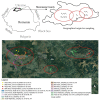Unravelling Heavy Metal Dynamics in Soil and Honey: A Case Study from Maramureș Region, Romania
- PMID: 37835231
- PMCID: PMC10573013
- DOI: 10.3390/foods12193577
Unravelling Heavy Metal Dynamics in Soil and Honey: A Case Study from Maramureș Region, Romania
Abstract
The study examined soil and honey samples from the Maramureș region, assessing potentially toxic elements and their concentrations. The highest concentrations were found for (Cu), (Zn), (Pb), (Cr), (Ni), (Cd), (Co), and (As), while (Hg) remained below the detection limit. Samples near anthropogenic sources displayed elevated metal levels, with the Aurul settling pond and Herja mine being major contamination sources. Copper concentrations exceeded the legal limits in areas near these sources. Zinc concentrations were highest near mining areas, and Pb and Cd levels surpassed the legal limits near beehives producing acacia honey. Nickel and Co levels were generally within limits but elevated near the Herja mine. The study highlighted the role of anthropogenic activities in heavy metal pollution. In the second part, honey samples were analyzed for heavy metal concentrations, with variations across types and locations. Positive correlations were identified between certain elements in honey, influenced by factors like location and pollution sources. The research emphasized the need for pollution control measures to ensure honey safety. The bioaccumulation factor analysis indicated a sequential metal transfer from soil to honey. The study's comprehensive approach sheds light on toxic element contamination in honey, addressing pollution sources and pathways.
Keywords: environmental biomonitoring; food quality analysis; heavy metal contamination in honey; honeybee population; polluted areas.
Conflict of interest statement
The authors declare no conflict of interest.
Figures


References
-
- Huang Z., Pan X.D., Wu P.G., Han J.L., Chen Q. Heavy metals in vegetables and the health risk to population Zhejiang, China. Food Control. 2014;36:248–252. doi: 10.1016/j.foodcont.2013.08.036. - DOI
Grants and funding
LinkOut - more resources
Full Text Sources
Research Materials

